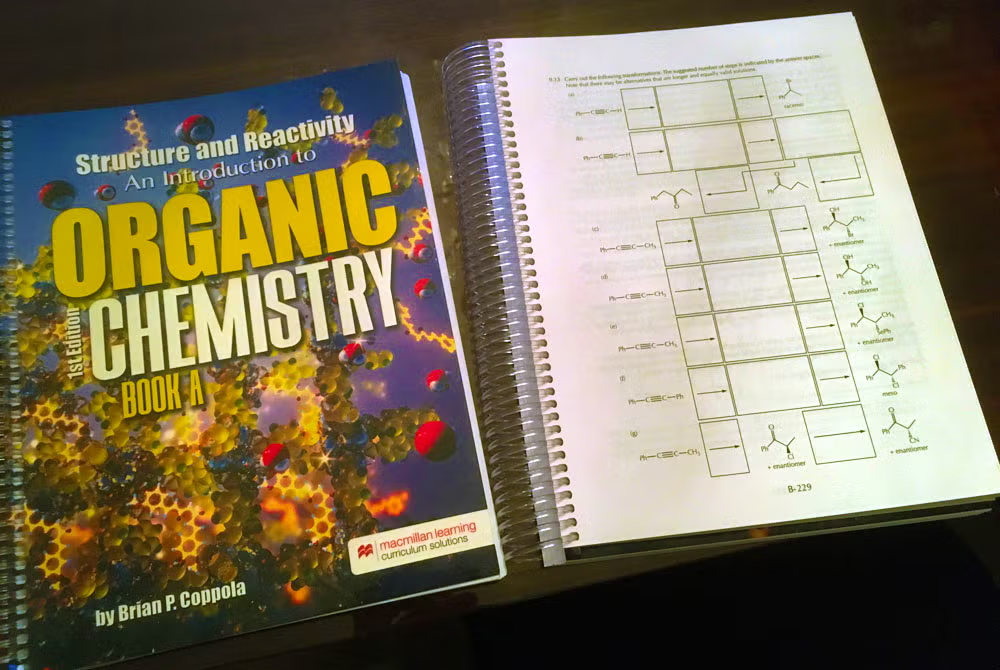Structure and Reactivity:
An Introduction to Organic Chemistry
by Brian P Coppola
is a 4-book series that provides a student-centered approach to the first-year undergraduate course in Organic Chemistry used at the University of Michigan. For an overview of the topics and pacing for Books A-D, see the summary contents.
The books are designed to expand the pedagogical mission of a standard textbook with detailed explanations, a guided analysis of important ideas, and a scaffolded set of open response questions to be worked on and filled in as the learner progresses. The approach is practical and to the point, reflecting the benefits of learning from thousands of students over 40 years. The writing style favors a more personal story-telling narrative that emphasizes explanation.
The text is the singular vision of its author. The project was self-funded and self-produced without changes being dictated by market forces or editorial demands. The book is a wholly owned property of the author. A Study Guide, including a complete answer key, is the only ancillary, and it is provided openly and at no cost. There are (by design) no PowerPoint materials, no test banks, no quizzes, nor any integration into an LMS. The back-to-basics effort has been focused on making an affordable book that students can learn from.
Individual copies can only be purchased through the single vendor serving the University of Michigan: Barnes and Noble.
First Edition (Second Printing) c. 2023 (Van Griner Learning)
The Book A/B bundle is used by CHEM 210 Structure & Reactivity I (ISBN 978-1-64565-276-2), the Book C/D bundle is used by CHEM 215 Structure & Reactivity II (ISBN 978-1-64565-279-3).
For adoptions by institutions, the author licenses the text for printing and distribution through Van Griner Learning. Contact me directly for more information (bcoppola .at. umich.edu).
Four volumes
The text comprises four volumes that are designed as convenient, portable workbooks to be carried around, written in, and record the ideas that their owners want to share, discuss, and debate with other students. Books A and B are used in the first term course (CHEM 210) and Books C and D are used in the second term course (CHEM 215).

Integrated textbook-workbook
These books are not produced to be preserved on a shelf, they are meant to be well used and written in. The four volumes are each about 550 pages and spiral bound, a convenient and portable workbook to be carried around, featuring about 950 pages (over 40% of the 2200 total pages) of open-format questions, include practice exam sets. All of the questions are formatted the same way our exam questions are formatted. Each subsection (1.1, 1.2…) is paced to our normal class day; each subsection is followed by a set of questions, and there is another set of questions at the end of each chapter. Eight sets of exam questions, curated from those were used on exams over the last 20 years, appear at the usual exam breaks (CH 1-3, CH 4-6, etc.).
The art program (all figures and questions) was produced by the author and so reflects an organic chemist’s sensibility and an experienced instructor’s aesthetic.
The origins of scientific ideas
Each chapter begins and ends with a short essay that connects the course content with ideas from history, philosophy, and other areas of science, particularly biochemistry. The concept that science is a common-sense activity used to answer questions and solve problems is a prevalent theme throughout the books.
Study Guide & Answer Key
Answers to 100% of the 1243 numbered questions, including added comments in some cases, are located at the freely accessible Study Guide web site (unavailable in print). The Study Guide includes open access to many details about the University of Michigan courses (CHEM 210 and CHEM 215) in which the books are used, including: (a) recordings of the classroom sessions (chalk talks on an actual blackboard) given by the author, (b) a more detailed image of the boards to follow along with, (c) Problems of the Day (extrapolations of book questions to ponder with others), and (d) some essays about learning and study strategies derived in great part from research carried out in the course itself.
eBook
All of the print copies come with a unique code that gives access to a DRM-protected e-book copy. The e-access is not sold separately, and it is accessible for about a year after activation. Three weeks into the course, the most common impression about having an available eBook by our students has been “eBook? What eBook?” Back to Basics.
Samples
Chapter 13.2 Text: Acylation chemistry mediated by acyl ammonium intermediates
End of section questions from Chapter 13.2
End of chapter essay from Chapter 13
End of chapter questions from Chapter 13 (Sections 13.1-13.4)
Exam questions from the second term course (Exam 2: CH 13-14)



